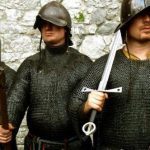 History
History  History
History  Animals
Animals Ten Times It Rained Animals (Yes, Animals)
 Mysteries
Mysteries 10 Devastating Missing Child Cases That Remain Unsolved
 Creepy
Creepy 10 Scary Tales from the Middle Ages That’ll Keep You up at Night
 Humans
Humans 10 One-of-a-kind People the World Said Goodbye to in July 2024
 Movies and TV
Movies and TV 10 Holiday Movies Released at Odd Times of the Year
 Politics
Politics 10 Countries Where Religion and Politics Are Inseparable
 Weird Stuff
Weird Stuff 10 Freaky Times When Famous Body Parts Were Stolen
 Miscellaneous
Miscellaneous 10 Interesting Things Manufacturers Stopped Making and Why
 Gaming
Gaming 10 Funny Tutorials in Games
 History
History 10 Desperate Last Stands That Ended in Victory
 Animals
Animals Ten Times It Rained Animals (Yes, Animals)
 Mysteries
Mysteries 10 Devastating Missing Child Cases That Remain Unsolved
Who's Behind Listverse?

Jamie Frater
Head Editor
Jamie founded Listverse due to an insatiable desire to share fascinating, obscure, and bizarre facts. He has been a guest speaker on numerous national radio and television stations and is a five time published author.
More About Us Creepy
Creepy 10 Scary Tales from the Middle Ages That’ll Keep You up at Night
 Humans
Humans 10 One-of-a-kind People the World Said Goodbye to in July 2024
 Movies and TV
Movies and TV 10 Holiday Movies Released at Odd Times of the Year
 Politics
Politics 10 Countries Where Religion and Politics Are Inseparable
 Weird Stuff
Weird Stuff 10 Freaky Times When Famous Body Parts Were Stolen
 Miscellaneous
Miscellaneous 10 Interesting Things Manufacturers Stopped Making and Why
 Gaming
Gaming 10 Funny Tutorials in Games
10 Truly Bizarre Things Kept at the Smithsonian
Washington D.C.’s Smithsonian Institution is home to millions of objects, including artwork, historical artifacts, and specimens of note spanning the history of the globe. It’s one of the most important museums and research facilities in the entire world. And because it houses so many objects—the majority of which are not on display to the public, or at least go on a rotating schedule for it—the massive museum complex is often called “America’s attic.” The nickname makes sense, as you never quite know what you’re going to find in there if given the opportunity to roam around freely.
With literally hundreds of curators on staff and thousands more employees working beneath them, the Smithsonian’s officers are constantly trying to figure out exactly what they have, where it’s located, and what state it’s in. That is a massive, never-ending endeavor, of course. But as they go through their items, the museum has given the world a look at some pretty strange stuff. In this list, we’ll uncover ten really bizarre items that are housed at the Smithsonian!
Related: 10 Oddly Wonderful Celebrity Museums Around The World
10 Famous Highway Asphalt
Obviously, the Smithsonian’s purpose is, in part, to document the distinctly American brand of history that came around after 1776 and, with it, American culture. Well, what would be more culturally iconic about America than a highway? We’re talking, like, a literal road—the asphalt and line markers and all! In 2000, the Smithsonian reached out to the state of Oklahoma and requested that they hand over the asphalt of a 50-foot-long (15-meter) stretch of Route 66.
Of course, Route 66 was instrumental in helping move Americans westward in automobiles in the first half of the 20th century before interstate highways became a thing. It was world-famous for having been mentioned and set as a scene in The Grapes of Wrath and countless other impactful American classics of literature, film, television, art, music, and more. And now, it’s in the Smithsonian!
Granted, the entirety of Route 66 runs from Illinois all the way across Missouri, Kansas, Oklahoma, Texas, New Mexico, and Arizona, and it eventually runs out straight into the Pacific Ocean in California. Much of the route is actually still passable, too, with the road having been paved over and smoothed out as the years have passed.
The museum’s (original pavement) portion comes just from the state of Oklahoma, though. But still, it’s a true chunk of Americana, and it’ll now be preserved in perpetuity in the museum’s massive collection.[1]
9 Interesting Infomercial Info
Not every item housed in the Smithsonian is a serious thing dealing with an important and life-changing moment in history. Some items—like the Veg-O-Matic—are in their collection because of how unique and strange they are. The Smithsonian has in its curation department the Veg-O-Matic II (if we’re going to be technical), which was an infomercial sensation first put forth by the notorious Popeil Brothers.
First invented by Samuel J. Popeil, it was his son Ron who made the Veg-O-Matic famous in the first place. That’s because he took it to television in the 1980s and began aggressively selling it and other O-Matic devices on late-night infomercials. The Popeil push went viral decades before going viral was a thing, and the Veg-O-Matic II started moving major units. Thanks to the success of the product’s loud, brash, and aggressive advertising, millions of consumers took notice.
They weren’t the only ones, though; the nation’s biggest and most renowned museum did, too. In 1986, the Smithsonian asked the Popeil family if they could have one Veg-O-Matic for their collection, and the advertising bunch acquiesced. Ron donated one for the curator’s collection. With it, he even sent along a recording of his iconic on-air infomercial pitch, complete with “But wait! There’s more!”[2]
8 Cher Ami
Cher Ami (or “dear friend” in English) was the name of a carrier pigeon that flew a dozen missions for the U.S. Army and its allies during World War I. The soldiers gave it that name because it was incredibly brave in flying across dangerous areas and taking on enemy gunfire. Without Cher Ami’s ability to fly to a point and deliver crucial intelligence messages, it’s likely far more American and Allied soldiers would have been killed in several specific battles with their German foes.
The most infamous of these incidents occurred on October 4, 1918. On that day, the U.S. Army’s 77th Infantry Division had become trapped in a precarious spot behind German lines. U.S. troops on the other side of the line tried to fire artillery rounds into the German position to help cover their trapped colleagues inside.
But the Americans weren’t quite sure where the 77th was, and the shells quickly began bombing the very soldiers they were being fired off to protect. Major Charles Whittlesey was in charge of the 77th, and he had several pigeons at his disposal to get messages out. Unfortunately, his first pigeons were all shot down, and messages he’d meant to send to his colleagues begging them to cease fire were going undelivered.
But that’s where Cher Ami shined. Major Whittlesey sent him out into the air with a message meant for their American colleagues. By then, not only were the Americans mistakenly bombing the 77th, but German forces had also caught wind of their location and were firing artillery into their hiding spot, too.
But Cher Ami somehow made it through the barrage and flew more than 40 kilometers—about 25 miles—in just over 25 minutes. He suffered brutal injuries during the flight, losing an eye to one bullet and suffering another bullet hole from a shot straight to his breastbone. By the time he got to the American camp where he was meant to deliver the message, Cher Ami had nearly died from both those wounds, and a third one had almost completely severed one of his legs.
He made it to the camp, though, and he delivered Major Whittlesey’s message as intended. In turn, it saved the lives of 194 soldiers in the “Lost Battalion.” Those men would have undoubtedly been killed by German assailants—if not accidentally by friendly fire. For his incredible work on that fateful day, Cher Ami’s body now rests carefully as an honored historical artifact within the Smithsonian.[3]
7 Sunstone Sanctity
The Church of Jesus Christ of Latter-Day Saints first began construction on their Nauvoo Temple in Illinois way back in 1841. We know that church more commonly as the Mormons, of course. They were hoping to find Illinois to be a land of freedom where they could worship as they saw fit, but it wasn’t meant to be.
They spent much of the 1840s constructing the temple. Their construction included carving out several massive sunstones, moonstones, and starstones. By the end of the decade, there were 30 of each kind within and around the temple. But sadly, long-term worship there wasn’t meant to be. After an arson attack in 1848 and a tornado in 1850, major parts of the temple were quickly destroyed.
The Mormons figured those were signs, and they moved further west. Of course, they would eventually land in Utah and build out their community there. But the sunstones that were formed back in Nauvoo weren’t meant to be forgotten by history. In 1989, the Smithsonian bought one of the only two sunstones that were known to have survived the last 150-ish years from the first temple’s brief existence. For the cool price of $100,000, the museum got themselves a 5,000-pound sunstone to lug around forever.
The stone features an intricate face carved into a sun that is breaking away from a cloud bank underneath two heavenly trumpets. The detail and unique nature of the sunstone hold quite a bit of importance for Mormon culture, as well as for history buffs keen on commemorating major events and movements in America’s past.[4]
6 The Bubble Boy’s Suit
From John Travolta to George Costanza and Jake Gyllenhaal, the idea of the so-called “Bubble Boy” is a common one in recent American lore. But the real story was a true tragedy. In 1984, 12-year-old David Vetter died from severe combined immunodeficiency after living in a bubble suit that doctors hoped would keep him away from harmful infections.
Vetter had just received a bone marrow transplant in an attempt to improve his life, but the pioneering medical procedure didn’t work, and Vetter passed away far too young. After his death, much was made of the suit in which he spent nearly all of his brief life. Technically called an “isolator” but known casually to most people as the “bubble suit,” the NASA-built mobility bubble was unique and advanced for its time.
The suit cost more than $50,000 to specially make, and it came with a 50-plus page instruction manual for its use. And while the suit scared David the first time he entered it, once he got inside, the young boy found that he could suddenly go outside more often and see parts of society again. He was able to interact in small ways with people, he could walk around for more than a few steps in any direction, and his world expanded.
That made it all the more tragic, then, when he passed away in 1984 after the bone marrow transplant attempt. In the aftermath of his death, the Smithsonian actually acquired his full bubble suit. They also picked up the mobile support vehicle that accompanied him on his jaunts out into the world. And, for good measure, they have in their collection one of his stationary isolation units that the child used at home, as well as several of his personal possessions, including drawings, toys, and games.[5]
5 Indiana Jones Memorabilia
Movie buffs know all about the lore behind Indiana Jones. First appearing in Raiders of the Lost Ark in 1981, Indiana Jones has returned to the big screen multiple times after that massively successful movie. Take Indiana Jones and the Temple of Doom in 1984, Indiana Jones and the Last Crusade in 1989, and Indiana Jones and the Kingdom of the Crystal Skull in 2008. And who could forget Indiana Jones and the Dial of Destiny, which came out in the summer of 2023 as the fifth and final installment of Harrison Ford’s unforgettable work on screen as the titular character.
Of course, Ford plays the renowned archaeologist in all the movies, making waves on the silver screen by rushing from one adventure to the next. He teases out the mysteries of the ancient world, rescues people (always beautiful women!) in distress, and vanquishes every sketchy treasure hunter and plunderer he can find. But everybody knows that, right? Well, what if we told you that Indiana Jones’s stuff is actually in the Smithsonian!
One of Jones’s most famous lines in the movies is his demand that important artifacts be carefully pulled in, categorized, cataloged, and held in museum collections for safekeeping. “That belongs in a museum,” Ford often roars as Jones on the big screen. And in 1989, he and the film giant’s Lucasfilm overseers made sure to do just that.
The production company donated both Jones’s iconic fedora and his snugly-fitting leather jacket to the museum. And not content to stop there, a decade later, they donated the character’s bullwhip to the preservation complex, as well. Life imitates art![6]
4 Sewell’s Heart Pump
In the late 1940s, Yale School of Medicine student William H. Sewell put together a functioning heart pump. Compared to what we have in the medical community for heart health today, it was a primitive device. But it worked, and it was a fully functioning item that propelled cardiology forward far more than the year-plus it took to create between 1948 and 1949. And now, that pump resides in the Smithsonian. Sounds cool, right?
Well, sure, but that’s not the whole story. See, we weren’t kidding about Sewell’s heart pump being a primitive device. That’s because it was fabricated entirely out of the pieces of an Erector set! Instead of costing millions of dollars to test, manufacture, and produce, Sewell and his thesis adviser, William W.L. Glenn, spent a whopping $24.80 on the Erector set and a few extra pieces needed to make it happen.
There’s a motor for the pump, and the whole thing is pneumatically powered. There is also an assortment of glass tubes, connectors, valves, and cams—the combination of which Sewell was easily able to find either (a) already lying around the science lab or (b) after a quick trip out to the local five-and-dime store. All the pump needed after assembly was to be hooked up to a tank of compressed air and a vacuum pump—and voila! It became an actual working model!
Sewell’s heart pump actually worked in several different experiments with dogs, too, proving that the Erector set had what it takes to keep a creature alive. Of course, human heart pumps and other cardiologic equipment have come a long way since that time. But Sewell’s pioneering and inventive creation was critical in propelling medicine forward![7]
3 Automation… for Monks
The Smithsonian boasts in its massive collection a 16th-century mechanized monk from Spain. Yes, you read that right: it’s a 15-inch (38-cm) tall wooden monk that is automated with a mechanized set of gears that allow it to make a few pre-designed movements. Wind the monk up, let it loose, and you’ll watch it move its mouth open and closed as though it’s chanting while pacing out a few steps and rhythmically raising its arms into positions of several devotional movements.
The mechanized action of the monk is strange, of course. And the backstory behind it is even weirder. Back in 1562, the crown prince of Spain was severely injured in a fall. The man, whose name was Don Carlos, threw Spain’s monarchy into disarray because of his awful injuries. His father, King Philip II, put together all kinds of medical treatments to be sure that his heir would survive his injuries in order to rule Spain after Philip’s death.
Unfortunately, none of the then-cutting-edge medical procedures were doing the trick. For a while, it looked like Don Carlos was going to die, and Spain’s monarchy would be left without a rightful heir. Then came the miracle. King Philip began praying to God and asked him to save Don Carlos. Whether it was God, fate, or the vagaries of medicine in that time period, things came together, and the young man did actually survive his injuries.
King Philip was so overjoyed about it that he commissioned a world-famous clockmaker to produce the mechanized monk as a show of thanks. The miniature monk was supposed to represent King Philip’s piety and gratitude for his son surviving and ultimately healing. Now, the bizarre little statue is just another head-scratcher that sits in the Smithsonian’s extremely varied collection.[8]
2 Poignant Presidential Mementos
There’s no shortage of presidential knickknacks at the Smithsonian. There are iconic items there like the cane Ben Franklin used and a tent George Washington once infamously slept in during battle. There are important historical artifacts, too, like patent applications filed by Abraham Lincoln and the microphone Franklin D. Roosevelt used to deliver his fireside chats to the American public during some of the nation’s most tumultuous years. But those are pretty basic offerings, right? Exactly the kind of thing we’d expect from the mega-museum. Let’s get weird!
In addition to the normal stuff, the Smithsonian’s collection boasts things like silk pajamas worn by Warren Harding. Harry S. Truman’s favored bowling pins are there, too—the man liked to bowl in his free time, and the Smithsonian has now ensured they have those pins for safekeeping forever.
If that’s not enough, how’s this for strange: the museum has a framed display of locks of hair that were cut from the heads of America’s first 14 presidents. That’s right; from Washington all the way through Franklin Pierce, the Smithsonian houses hair that came right off the top of each of their heads.
There are macabre presidential items in the collection, as well. Those include at least two keepsakes owned by presidents and used on the day(s) they were assassinated. The museum has in its collection the top hat worn by Lincoln on the day he was killed by John Wilkes Booth at Ford’s Theatre. It also has a cup William McKinley had just taken a drink from moments before he was shot by Leon Czolgosz in 1901. Creepy![9]
1 Fast Food Bun Gauge
The whole point of eating fast food is that you know exactly what you’re going to get (well, theoretically, at least). Fast food restaurants from coast to coast have standardized menu items that are identical to each other no matter where in the country you are. So, when you’re on a road trip or fixing for a bit of a treat, the consistency allows you to know exactly what you’re about to chow down on. That idea didn’t come around by accident, though.
Decades ago, when McDonald’s and other fast food giants were first spreading rapidly, the company’s executives wanted things standardized to ensure consumers would pick up on it and maintain brand loyalty. Enter the bun gauge. The bun gauge is a specific little tool that allows fast food workers to ensure the buns they are producing have uniform height, thickness, and circumference.
The gauge existed in the latter half of the 20th century—and still factors in today—as a way to ensure every single burger has the same kind of bun as every other burger made by the same joint. From Maine to California, if the employees are using the gauge like they should, you’re destined to enjoy the same burger experience despite the thousands of miles in between.
The Smithsonian thought that was a worthy thing to document, so they picked up a bun gauge for their collection. Now, they hold a piece of American fast food history in their mega-complex. Like many things we’ve learned about on this list, the bun gauge may be an unlikely museum item, but it’s undoubtedly a true part of Americana. And for that reason, it’s an ideal artifact for a museum like the Smithsonian![10]








